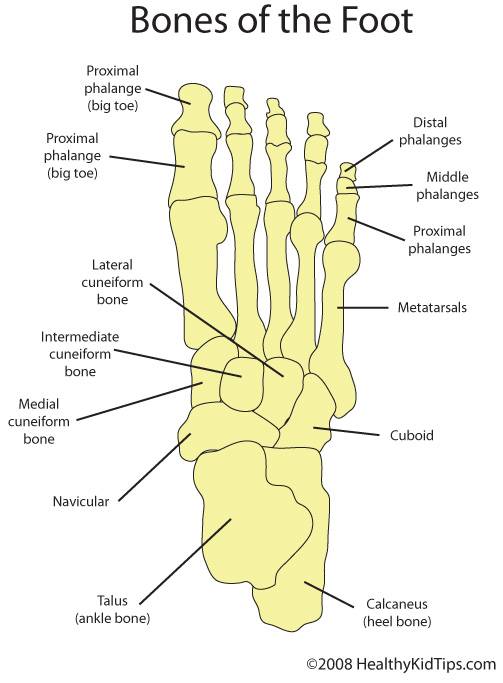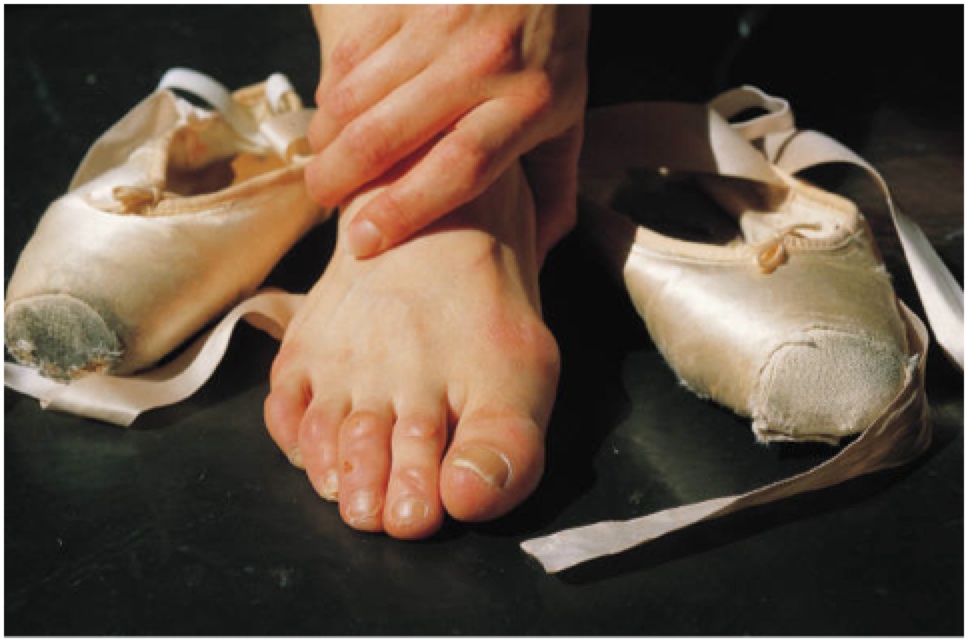The human body contains 208 bones, and 52 of them are in your feet.
 Your foot is arguably one of the most complex structures in the body, especially when you consider the purpose it serves for us dancers: support, balance, and propulsion.
Your foot is arguably one of the most complex structures in the body, especially when you consider the purpose it serves for us dancers: support, balance, and propulsion.
Much like the musician and his instrument, for us dancers it is crucial that we keep our feet in good working order.
Foot maintenance:
Dancers are notorious for their… um… not-so-attractive feet. “Pedicure” is not in our vocabularies! Here are some considerations for ways to prevent and treat minor injuries, and general care for your feet:
- Cut your toenails short, and straight across. The nail should be straight across and not curved because curved nails or nails that are too long can lead to ingrown toenails. The length of the nail should be *just* where the white part begins, with a very small amount of white showing. Use clippers as opposed to scissors to get a clean, straight cut.
- Don’t wear toenail polish. Polish prevents you from being able to see under the nail, so you can’t see if you’re developing a problem such as a bruised or ingrown nail. That doesn’t mean you can NEVER wear polish… go ahead and wear it for special events and then take it off before your next class, or, wear a clear polish that allows you to see the nail.

- Learn to love calluses. Dancers should keep their calluses trimmed if they are overly thick and causing pain (forexample, if it feels bumpy in your shoe or against the floor), but generally calluses are a really good thing. They help protect against blisters and abrasions, so avoid the urge to file them off!
- If you develop a blister: Blisters are par for the course in pointe work, especially as you break in new shoes. They can also result from rubbing in soft shoes or jazz shoes, or from harder tap or character shoes. Blisters can occur anywhere on your foot, but generally tend to pop up on the surface of the toes, inside or outside border of the metatarsals, or on the heel. Blisters can be painful – even the littlest ones! Below is some advice on how to treat the two main types of blisters:
- If you develop a clear colored blister, and the skin hasn’t broken, use a sterilized needle to pop the blister and drain out the liquid. Do not remove the loose skin; cover with a bandaid and strip of athletic tape. If the skin has begun to tear, use a small pair of scissors to remove any loose skin and cover with a bandaid and strip of athletic tape.
- If you develop a red colored blister, do not pop it. Blood blisters should be left to heal on their own; cover with a bandaid and strip of athletic tape.
- For painful blisters you can also cut the center out of a small piece of moleskin to form a donut shape. This prevents the surface of your shoe from rubbing on the blister until it heals. Cut a square or circle that’s bigger than your blister. Fold in half and make a slit. Putting the scissors through the slit, cut an inner circle the size of the blister. Remove the paper covering and stick the moleskin pad to surround the blister.
- Finally, check the fit of your shoe. Blisters are normal with new shoes, but if you are developing them on a regular basis you may want to see about a different style that better molds to your foot.
Take Inventory on Your Dance Bag:
Making sure you have everything you need is critical to foot maintenance, especially if you’re a pointe shoe dancer. Here’s a list of supplies I recommend keeping in your dance bag:
- Nail clippers
- Band aids
- Athletic tape
- Mole skin
- Extra lamb’s wool or toe pads
- Needle and thread
- Extra elastic
- Small pair of scissors
- Tennis ball or foot roller
While these are the essentials, the list of what can appear in a dancer’s bag goes on and on.
Pointe Magazine does a feature called “Show and Tell”, featuring various professional dancers and diving inside their bags (sometimes including really obscure things like Kit-Kat bars, good luck charms, and Vaseline).
Over time, as you get to know your feet better, you’ll discover what you really need (and what you should include for rainy day emergencies).
Share with me:
Do you have a story and/or picture of a foot injury that you can share? In part three of this series I would like to share a few readers’ stories about your experiences with foot and ankle injuries. Other questions to consider:
- What do you do to keep your feet in top condition?
- What’s the silliest/strangest thing in your dance bag?
Be sure to keep your eyes peeled on the social media sites to share your experiences, or leave in the comments below. A few reader stories will be featured in the column this March, right here on Dance Advantage!
More Meet Your Feet!
Lauren Warnecke is a freelance writer and editor, focused on dance and cultural criticism in Chicago and across the Midwest. Lauren is the dance critic for the Chicago Tribune, editor of See Chicago Dance, and founder/editor of Art Intercepts, with bylines in Chicago Magazine, Milwaukee Magazine, St. Louis Magazine and Dance Media publications, among others. Holding degrees in dance and kinesiology, Lauren is an instructor of dance and exercise science at Loyola University Chicago. Read Lauren’s posts.

